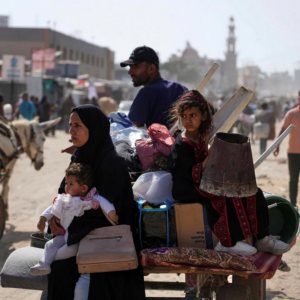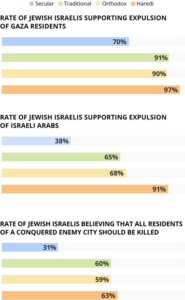Yes to transfer: 82% of Jewish Israelis back expelling Gazans

Displaced Palestinians flee from Khan Younis, Gaza, amid the ongoing Israeli military offensive in the area, late May 2025
Shay Hazkani and Tamir Sorek write in Haaretz on 28 May 2025:
A recent survey of Israeli Jews reveals a growing comfort with the idea of forcibly expelling Palestinians – both from Gaza and from within Israel’s borders. The poll also found that a significant minority supports the mass killing of civilians in enemy cities captured by the Israeli army. These disturbing trends reflect the radicalization of religious Zionism since Israel’s 2005 withdrawal from Gaza, and the failure of secular Israeli Jews to articulate a vision that challenges Jewish supremacy.
Commissioned in March by Pennsylvania State University and conducted by Tamir Sorek for the Israeli polling firm Geocartography Knowledge Group, the survey polled a representative sample of 1,005 Jewish Israelis. It posed a series of “impolite” questions – topics typically avoided in mainstream Israeli polling – about the Israeli-Palestinian conflict.
According to the results, 82 percent of respondents supported the expulsion of Gaza’s residents, while 56 percent favored expelling Palestinian citizens of Israel. These figures mark a sharp rise from a 2003 survey, in which support for such expulsions stood at 45 percent and 31 percent, respectively.
Religious interpretations play a key role in shaping these views. Nearly half (47 percent) of respondents agreed that “when conquering an enemy city, the Israel Defense Forces should act as the Israelites did in Jericho under Joshua’s command – killing all its inhabitants.” Sixty-five percent said they believed in the existence of a modern-day incarnation of Amalek, the Israelite biblical enemy whom God commanded to wipe out in Deuteronomy 25:19. Among those believers, 93 percent said the commandment to erase Amalek’s memory remains relevant today.
This apocalyptic rhetoric has found fertile ground in religious Zionist circles, where leaders have long advocated for such extreme policies.
One of the most influential figures to call for such policies is Rabbi Yitzchak Ginsburgh, head of the Od Yosef Chai Yeshiva in the West Bank settlement of Yitzhar. In January 2005, just before Israel’s dismantling of its Gaza settlements, Ginsburgh delivered a sermon near the Knesset that laid out a vision fundamentally at odds with the secular Zionist ideal of a “Jewish and democratic state.”
Ginsburgh gained notoriety for his pamphlet “Baruch Hagever” (“Baruch the Man”), which praised Baruch Goldstein, the settler who massacred 29 Muslim worshippers in Hebron’s Cave of the Patriarchs in 1994. Following the assassination of Prime Minister Yitzhak Rabin in 1995, Ginsburgh was placed under administrative detention. He later endorsed a book that sanctioned the killing of non-Jewish women and children.
Unlike the early leaders of the Gush Emunim settler movement, Ginsburgh views any Palestinian presence in the Land of Israel as a desecration of God’s name. His 2005 sermon, now known as “Time to Crack the Nut,” was a call to embrace Jewish supremacy in the Land of Israel. It prepared his followers for mass violence and ethnic cleansing – policies that, two decades later, appear to be unfolding in Gaza. With Ginsburgh’s vision seemingly coming to fruition, it is worth revisiting the ideological framework he proposed.
***

Displaced Palestinians flee from Khan Younis amid the ongoing Israeli military offensive in the area on 19 May 2025
Born in the United States in 1944, Ginsburgh began his rabbinic career in the Chabad movement. Though he still resides in Kfar Chabad, his greatest influence is among nationalist Haredi Jews within the religious Zionist movement. His teachings blend Hasidic mysticism with messianic nationalism, drawing inspiration from Rabbi Abraham Isaac Kook and the Revisionist Zionist movement. His appeal even extends to some secular Israelis, drawn to his New Age-inflected ideas and his concept of “Jewish psychology.”
The most radical followers of Ginsburgh’s ideology are the so-called “hilltop youth” – violent, young settlers from illegal outposts – who now form an armed militia responsible for frequent attacks and occasional killings in West Bank villages. Unlike the early leaders of the Gush Emunim settler movement, who at least nominally accepted the idea that Palestinians could remain in the land as a ger toshav (a halakhic term for a non-Jew living in the Land of Israel) without political rights, Ginsburgh views any Palestinian presence in the Land of Israel as a desecration of God’s name.
In his “nut cracking” sermon, Ginsburgh likened the State of Israel to a nut with four shells encasing the fruit – the Jewish people. Drawing on Kabbalistic concepts, he described these shells (kelipot) as spiritual impurities, remnants of creation that must be shattered to release divine sparks. While some shells may contain traces of holiness, most are aligned with evil – the sitra achra, Aramaic for “other side.”
To bring about redemption, the shells must be broken. The first three – the media, the judiciary, and government institutions – are irredeemably impure and must be destroyed.
Initially, Ginsburgh argued, these shells were necessary for the Jewish people’s development. But now, he claimed, they have become obstacles. To bring about redemption, the shells must be broken. The first three – the media, the judiciary, and government institutions – are irredeemably impure and must be destroyed. The fourth, the military, can be salvaged, but only if its moral foundations are purged.
The secular media, Ginsburgh stated, “creates an atmosphere in which speaking in the name of Torah is seen as anachronistic, primitive and irrelevant to all conversations essential to our lives.” The legal and justice system encourages “assimilation and blurring the differences between Israel and the nations.” It receives frequent assistance from the educational system, “which also strives … to impose those foreign and confusing values on the youth.” The Knesset and government advance interests alien to the Jewish people.
The cracking of these three shells is nearing completion, with the rapid pace of regime change stemming from Prime Minister Benjamin Netanyahu’s judicial overhaul, the crushing of the education system and the widespread abandonment of the professional ethos within the Israeli media.
The army is the most important and useful of these shells, Ginzburg argues. It is “soft and easy to digest.” Its cracking will release the divine substance inherent in it in an apocalyptic process. Ginsburgh asserts a simple Jew who will rely on a primal desire for revenge – whom he calls “the nutcracker” – will instigate this process.
That person shall not be bound by the military’s emasculating rules, those Gentile values associated with the so-called “purity of arms” that prevent soldiers from fulfilling the Talmudic commandment, “if someone comes to kill you, rise up and kill him first.” That same nutcracker will take revenge against the Gentiles, the Arabs of the Land of Israel, without moral constraints. He will emulate Baruch Goldstein, or the biblical Shimon and Levi, who killed all of the residents of Shechem after the rape of their sister Dina.
This was not an end-of-time prophecy. As early as 2005, Ginsburgh articulated a clear vision upon which his followers should act. But the plan required a window of opportunity to crack open the nut, a time when vengeance could be spontaneously and organically applied to the Gentiles so that the divine substance would be released from the shell. At that point, all that would then remain would be the fruit, the people of Israel, ready to take on the time of salvation. At the moment of vengeance, Ginsburgh believes, the avengers can also free themselves from the shackles of halakha, or Jewish religious law, which restricts bloodshed.
The opportunity presented itself on October 7, 2023, following the Hamas massacre of civilians in Israel. “The wicked acts of the people of Gaza underscores their Amalek-like features,” he wrote in his “Niflaot” pamphlet on the weekly Torah portion a few weeks after the massacre. These features, he added, “demands that we observe the command ‘Blot out the memory of Amalek from under heaven, you shall not forget it’ – total annihilation, not sifting,” meaning not checking who is innocent and who is guilty. Sacrificing the hostages by refusing any deal to secure their release is a reasonable price to pay for what the rabbi, like Netanyahu, calls “total victory.”
The secular public’s widespread adoption of positions in support of ethnic cleansing and genocide is more evidence of the realization of Ginsburgh’s vision. That public has failed to articulate an alternative vision to messianic Zionism in the form of human rights for all. Thus, 69 percent of secular Israelis in the Penn State survey supported the expulsion of Gazans, while 31 percent of them considered Joshua’s extermination of Jericho’s residents as a precedent that the IDF should adopt.
***
Ginsburgh’s achievement is indeed a result of cracking the shells, even if the ones doing the cracking were mostly not his actual supporters. The Hebrew media, the first shell, was always mobilized in support of the state, but it carefully maintained an aura of professionalism. Since October 7, it has pretty much abandoned this posture. Now, many journalists have foregone critical coverage. Some have even joined the calls for revenge, expulsion and extermination.
The judiciary once refused to openly declare Jewish supremacy in the Land of Israel and the right to expel, exterminate or starve the Jews’ enemies, even as it supported the occupation. Ginsburgh likened the judiciary to a stumbling block that “we must break … with derision and ‘contempt of court.'” It seems that the second shell has also splintered, if it hasn’t already been completely removed.
If there is any chance of stopping the march toward a Spartan, outcast society, it lies in the rejection of the idea of Jewish supremacy and Judaization, even in the version currently accepted by secular Zionism. The alternative vision to suicidal messianism is a true, equal partnership between the river and the sea.
Two months ago, Supreme Court Justice David Mintz rejected a petition by the human rights group Gisha to order Israel to supply humanitarian aid to the Gaza Strip. Mintz, a resident of the West Bank settlement of Dolev, asserted that this was a “war of commandment” just like in the Torah. He effectively authorized the denial of food, water and medicine to 2 million Gazans. The ruling, joined by Supreme Court President Isaac Amit and Justice Noam Sohlberg, a resident of the Alon Shvut settlement, is already taking its toll.
The educational system, part of the second shell, has become a workplace where Jewish teachers promoting universal values risk dismissal (Arab teachers have long been familiar with this danger). Scholars of education point to a sharp shift in the curriculum’s nationalist, ethnocentric direction since the second intifada. It has led to growing support for expulsion and extermination, especially among those who completed their education in the past 20 years.
Some 66 percent of those under age 40 support expelling Palestinian citizens of Israel, and 58 percent want to see the army follow the path laid down by biblical Joshua in Jericho. A generational gap in political positions is not an unusual phenomenon, but in Israel, it has widened greatly since 2000.
What has happened in the Knesset and the government also neatly follows the rabbi’s prophecy. Ginsburgh himself demanded: “We must eradicate the government – left or right – it must be overthrown. And when a new one is established, it must be overthrown as well, and so on, until a Torah-based government is established in the country.” Ginsburgh could boast quite a bit of divine support after five elections in three and a half years.
With the fourth shell, the goal has also been practically achieved. It’s hard to find any soldier who would refuse illegal orders, such as starving hundreds of thousands of people, creating kill zones, or bombing densely populated residential neighborhoods. Only 9 percent of men under 40, the main demographic group serving in the IDF in Gaza, rejected all the ideas of deportation and extermination presented to them.
Ginsburgh has not missed the fundamental change in policy taking place in the current war. He was exalted to learn that the IDF no longer considers the presence of civilians, “who constitute a shelter for terrorists,” in his words, as reason not to act. Last September, he congratulated the heads of state “on the change for the better” that has taken place in their position.
***
Some see the shock and anxiety that gripped the Israeli public in the wake of October 7 as the only explanation for this radicalization. But it seems the massacre only unleashed demons that had been nurtured for decades in the media and the legal and educational systems. Zionism, besides being a national movement, is also a movement of immigrant-settlers, seeking to displace the local population. Settler-immigrant societies always encounter indiscriminate violent resistance from indigenous groups. The desire for absolute and permanent security can lead to an aspiration to eliminate the resisting population. Therefore, virtually every settlement project has the potential for ethnic cleansing and genocide, as indeed happened in North America in the 17th through 19th centuries or in Namibia in the early 1900s.
To be sure, Ginzburg is not the cause of Israel’s moral collapse. But the nationalist Haredi movement, with Ginsburgh as one of its most prominent leaders, offers Israelis a religious veneer for erasing Palestinian indigeneity. It provides a language and a plan of action for both observant and secular Israeli Jews who seek a solution to the conflict that doesn’t force them to cede the privileges granted by a regime of Jewish supremacy.
The use of biblical language to justify war crimes is likewise not a novelty of Zionism. Puritan settlers in America, Ireland and other places seized on the Bible and compared the indigenous populations who opposed them to Amalekites and Canaanites. They too resorted to ethnic cleansing and genocide against the natives.
Palestinians make their way with belongings as they flee their homes after the Israeli military issued orders for evacuation from eastern Khan Younis, in the southern Gaza Strip, May 19, 2025.Credit: Hatem Khaled/ REUTERS
Note that this process is not deterministic. While messianic Zionism seeks to block decolonization in Israel and Palestine, it doesn’t make it impossible. Opponents of messianism have had several opportunities where they could have chosen a different path, but the price was that they would have to reinvent themselves as Israelis, and dismantle the regime of Jewish supremacy. Absent a willingness to make these changes, the door remains open to the impetuous spirit of Ginsburgh and his ilk.
If there is any chance of stopping the march toward a Spartan, outcast society, it lies in the rejection of the idea of Jewish supremacy and Judaization, even in the version currently accepted by secular Zionism. The alternative vision to suicidal messianism is a true, equal partnership between the river and the sea.
Shay Hazkani is a professor of history and Jewish studies at the University of Maryland. He is the author of “Dear Palestine: A Social History of the 1948 War” (2021).
Tamir Sorek is a professor in the History Department of The Pennsylvania State University. He is the author of the book “The Optimist: A Social Biography of Tawfiq Zayyad” (2020).
This article is reproduced in its entirety
